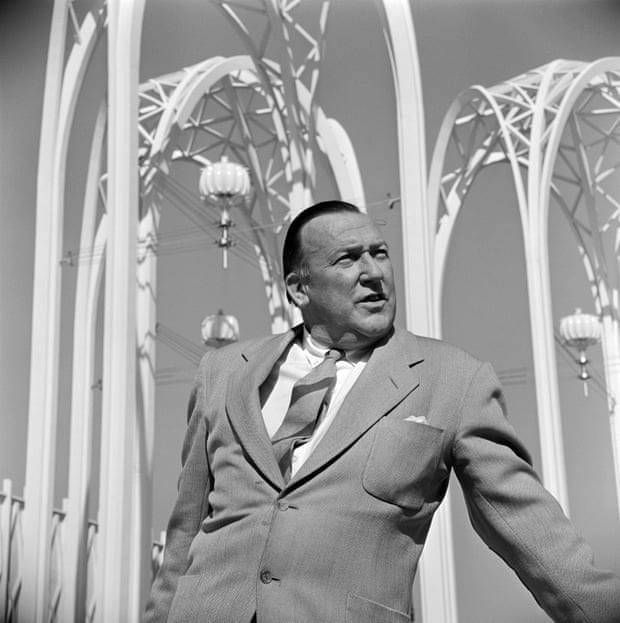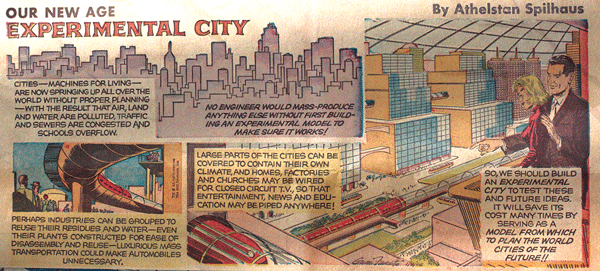Futurist Athelstan Spilhaus Led a Life Nearly As Curious as His Name

Some people's lives seem like the strange-but-true stuff of science fiction dreams. Such is the case for one Athelstan Spilhaus. Athelstan, who, you wonder? Allow us to explain.
In his 86 years firmly spent on Planet Earth, Spilhaus was involved in a rumored alien landing, the creation of the Minneapolis skyways, the indirect education of John F. Kennedy, Jr. using comic strips and designing a futuristic domed city in northern Minnesota.

Athelstan Spilhaus was born in South Africa in 1911. Following a prestigious academic career - including getting a masters degree in aeronautical engineering at MIT and a doctorate in oceanography from the University of Cape Town - Spilhaus built an international reputation. While Assistant Director at the Woods Hole Oceanographic Institute, he invented the Bathythermograph, an instrument - not a sneeze - that measured ocean depths and temperatures from a moving vessel (which proved indispensable in submarine warfare). He started the meteorology and oceanographic department at New York University and, from 1941 until 1945, Spilhaus served in the U.S. Army teaching meteorology and supervising a network of weather stations. All that by the ripe young age of 34.
In 1948, Spilhaus became the Dean of Science and Technology at the University of Minnesota. In his nearly two decades in our great state, he supported the establishment of a Sea Grant Universities program for oceanographic education and research (which was established by Congress in 1966), developed the ingenious idea for the Minneapolis skyways (which were built in the '50s), dared to dream up the plans for Minnesota's Experimental City - a venue in which he planned to test new urban designs in real-world conditions.
Minnesota’s Experimental City was born out of an idea in the late 1960s that one could solve all the problems of 20th Century urbanization by relying on science and technology to plan every aspect of growth. Discover more about Spilhaus' ideas.
Also while living in Minnesota, Spilhaus came up with a simple, but brilliant idea to get kids interested in science and technology. In 1955, "Our New Age" first appeared in the comics section and would go on to run in more than 100 US and 19 international newspapers, an accomplishment that later prompted John F. Kennedy, Jr. to tell Spilhaus, "The only science I ever learned was from your comic strip in the Boston Globe."

In the late '40s, Spilhaus was asked to take part in geophysical studies to design balloons to monitor atmospheric waves. These balloons became part of an Air Force system used to spy on Soviet nuclear testing. When one of them crashed in eastern New Mexico, the Air Force quickly cleaned up the wreckage to keep the project secret. The mysterious wreckage - and subsequent disappearance of the wreckage - led to deep-seated rumors of an alien landing.
Spilhaus' career is full of awards and accolades, including but not limited to: being the first U.S. representative to the UN Educational, Scientific and Cultural Organization (UNESCO); commissioner to the Seattle World's Fair (his U.S. Science exhibit endures today at the Pacific Science Center); president of the American Association for the Advancement of Science; fellow of the Woodrow Wilson International Center for Scholars; consultant to the National Oceanographic and Atmospheric Administration; and author of 11 books and 300-plus published articles.
He once told a friend who asked why he did so many things: "I don’t do ‘so many things.’ I do one. I think about the future."
A certain “je ne sais quoi,” a hefty dose of guts and machismo, defined the men of NASA’s earliest program in the race to send the first humans into space. The seven astronauts – the Mercury 7, as they were known – definitely had what writer Tom Wolfe called “The Right Stuff,” as he explained in a Saint Paul Airport hangar in 1980.
Two Minnesota husband-and-wife teams – the Piccards and the Winzens – pioneered high-altitude ballooning in the years leading up to the Space Race. Discover more about their stories.
Meanwhile, in Northfield, Minn., the G. T. Schjeldahl Company made a strategic move to leverage its innovative designs for plastic bread bags to develop inflatable sounding balloons that were sent into the atmosphere. Dubbed “satelloons,” the invention was part balloon, part satellite. Read all about it.
